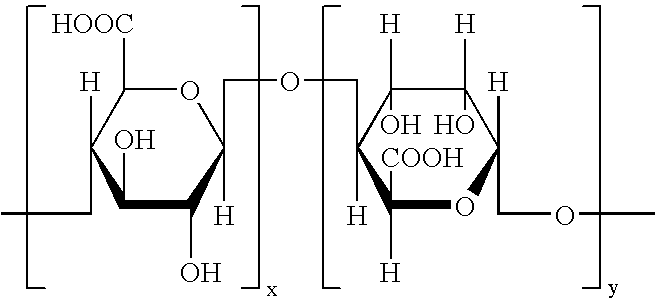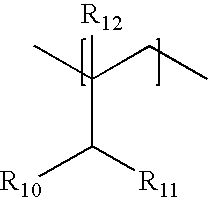Modified alginic acid of alginic acid derivatives and thermosetting anti-reflective compositions thereof
- Summary
- Abstract
- Description
- Claims
- Application Information
AI Technical Summary
Benefits of technology
Problems solved by technology
Method used
Image
Examples
example 1
[0057](A) 200 grams of alginic acid (ISP Corp.) was dispersed in a large amount of deionized water (˜3 liters) with stirring for about thirty minutes at room temperature. The dispersion was then filtered. The remaining solids were then placed in a suitably sized beaker and a sufficient amount of acetone was added to form a slurry. The slurry was stirred for about thirty minutes and then filtered. The remaining solids were then placed into a suitably sized beaker and a sufficient amount of acetic acid was added to form a slurry. The slurry was stirred for about thirty minutes and then filtered. The acetic acid slurry process was repeated once more. The remaining solids (after filtering) were placed into a 3 liter jacketed flask which was fitted with a stirrer and thermometer. 700 ml acetic acid and 1300 ml acetic anhydride were added to the flask with stirring. The flask was cooled to about 5° C. 8 grams of 98% H2SO4 was then added to the flask. The temperature of the flask was then ...
example 2
[0061](E) 50 grams of acetyl alginate prepared in Example 1 ((A)) was suspended in 450 grams of ethyl lactate in a suitably sized jacketed flask (fitted with a stirrer and thermometer). 4.87 grams of triethylamine and 10 grams of deionzied water were added and the resulting mixture was stirred for about 30 minutes at RT. 4 grams of benzyltriethylammonium chloride was then added, followed by 100 grams of 1,2-epoxy-3-phenoxypropane. The contents of the flask were then raised to about 85° C. and stirred at this temperature for 2 hours. The temperature was then reduced to about 75° C. 100 grams of propylene oxide were added to the mixture and stirred for about 1 hour at 75° C. 25 grams of hydrogen peroxide (50%) was then added to the mixture and the mixture was stirred for another 2 hours at 75° C. The mixture was then cooled to RT and filtered. The filtrate was slowly poured into large amount of water to precipitate the polymer. The polymer was filtered, washed thoroughly with water an...
example 3
[0064](H) 50 grams of acetyl alginate prepared in Example 1 ((A)) was suspended in 450 grams of ethyl lactate in a suitably sized jacketed flask (fitted with a stirrer and thermometer). 4.87 grams of triethylamine and 10 grams of deionzied water were added and the resulting mixture was stirred for about 30 minutes at RT. 4 grams of benzyltriethylammonium chloride was then added, followed by 100 grams of styrene oxide. The contents of the flask were then raised to about 85° C. and stirred at this temperature for 2 hours. The temperature was then reduced to about 75° C. 300 grams of propylene oxide were added to the mixture and stirred for about 1 hour at 55° C. 25 grams of hydrogen peroxide (50%) was then added to the mixture and the mixture was stirred for another 24 hours at 55° C. The mixture was then cooled to RT and filtered. The filtrate was slowly poured into large amount of water to precipitate the polymer. The polymer was filtered, washed thoroughly with water and dried in a...
PUM
| Property | Measurement | Unit |
|---|---|---|
| Solubility (mass) | aaaaa | aaaaa |
| Light | aaaaa | aaaaa |
Abstract
Description
Claims
Application Information
 Login to view more
Login to view more - R&D Engineer
- R&D Manager
- IP Professional
- Industry Leading Data Capabilities
- Powerful AI technology
- Patent DNA Extraction
Browse by: Latest US Patents, China's latest patents, Technical Efficacy Thesaurus, Application Domain, Technology Topic.
© 2024 PatSnap. All rights reserved.Legal|Privacy policy|Modern Slavery Act Transparency Statement|Sitemap



